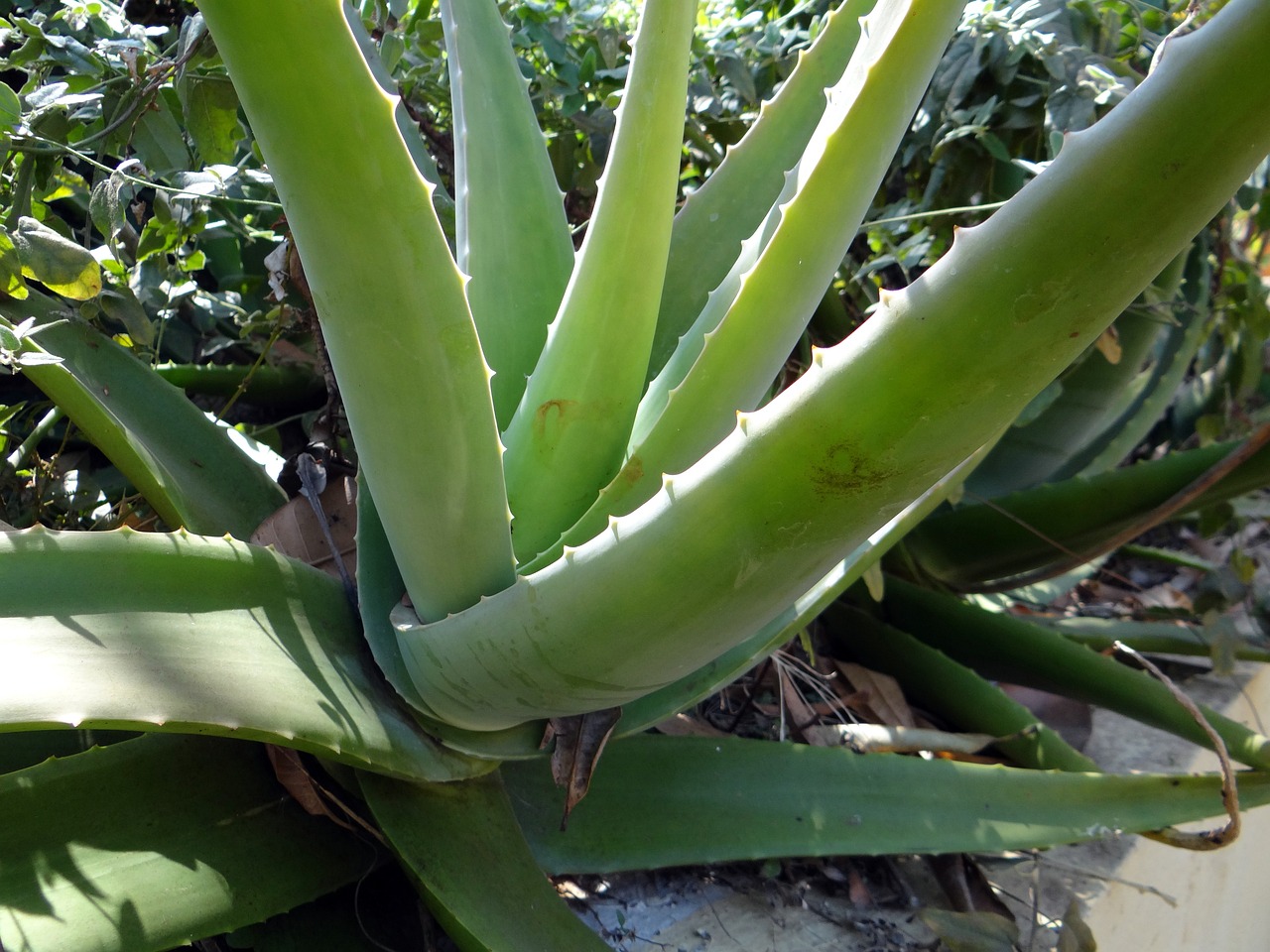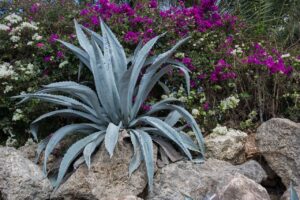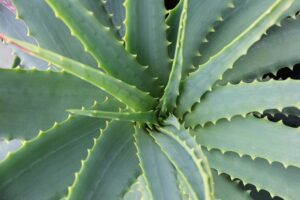Aloe Vera
Overview
Aloe Vera is a versatile and resilient succulent, famed for its decorative appeal and medicinal properties. Originating from the Arabian Peninsula, it flourishes in dry conditions but is found worldwide. Revered since ancient Egyptian times, Aloe Vera provides health benefits through its nutrient-rich juice and is cultivated both for its unique look and therapeutic leaves. Despite its benefits, it’s also known as an invasive species in some regions.

Characteristics
Known for its succulent structure, medicinal properties, and adaptability to dry, tropical, and semi-tropical climates.
Region
Found in tropical, semi-tropical, and arid climates worldwide, originally from the Arabian Peninsula.
Natural Habitat
Aloe Vera is typically found in dry, arid environments such as deserts and rocky terrains.
Cultivation
Requires well-drained soil, abundant sunlight, and minimal watering.
Uses and Benefits
The Aloe Vera plant is a true all-rounder, celebrated for its wide range of uses and benefits. The clear, gel-like substance found within its plump leaves is packed with nutrients and beneficial compounds that make it a popular choice for various applications.
When it comes to skincare, Aloe Vera is a fan favorite. Its soothing and healing properties make it an excellent remedy for:
- Sunburns
- Minor cuts
- Bruises
But the benefits of Aloe Vera go beyond topical use. Consuming Aloe Vera juice can provide several advantages for your internal health, such as:
- Aiding digestion: Aloe Vera juice may help improve digestive function and promote regular bowel movements.
- Boosting immune health: The plant contains compounds that can support your immune system, helping your body fight off infections and diseases.
- Supporting weight management: Some studies suggest that Aloe Vera juice may assist in weight loss efforts when combined with a healthy diet and exercise.
Not only does Aloe Vera bring a touch of greenery to your living space as a decorative plant, but its medicinal qualities have also been recognized and utilized for centuries. Ancient Egyptians valued Aloe Vera for its wellness properties, and this wisdom continues to be relevant in our modern lives4.
Whether you choose to grow Aloe Vera on your windowsill or incorporate its extracts into your daily routine, this plant offers a natural and time-tested approach to enhancing your overall well-being.

Cultivation Tips
For those with a green thumb or even for new garden enthusiasts, cultivating Aloe barbadensis can be a gratifying experience. Bearing its desert ancestry in mind, ensure your Aloe Vera plant is nestled in well-draining soil — a cactus mix works wonderfully. The plant prefers a sunny spot, so aim for a bright location, but not where the sun is too harsh, especially during scorching summer afternoons.
Aloe Vera doesn’t need much water. In fact, overwatering is a common misstep. Water deeply but infrequently, allowing the soil to dry out between waterings. Here are some key tips for successful Aloe Vera cultivation:
- Plant in a pot with drainage holes to prevent waterlogging
- Use a well-draining potting mix, such as a blend designed for cacti and succulents
- Place your Aloe Vera in a bright, sunny spot that receives at least 6 hours of sunlight daily
- Water thoroughly when the top 1-2 inches of soil feel dry to the touch
- Reduce watering frequency during the winter months when the plant is dormant
- Fertilize sparingly, if at all, as Aloe Vera is accustomed to nutrient-poor soils1
This simplicity in care makes Aloe Vera not only a healer of sunburns and cuts but also an ideal companion for those looking to add a touch of green without a high-maintenance commitment.
Seasonal Considerations
When caring for your Aloe vera, it’s essential to consider the changing seasons. During the spring and summer, when the plant is actively growing, it will appreciate more frequent watering. However, be cautious not to overwater, as this can lead to root rot. Allow the soil to dry out completely between waterings, and if in doubt, err on the side of underwatering. Aloe Vera is a resilient plant that can bounce back from a bit of drought stress, but it’s much more difficult to recover from being waterlogged.
As the cooler months approach, it’s time to adjust your Aloe Vera care routine. In the fall and winter, the plant goes into a state of semi-dormancy, and its water requirements significantly decrease. During this time, water your Aloe Vera sparingly, only when the soil is thoroughly dry. A good rule of thumb is to water about once a month during the winter, but always check the soil first to ensure it’s not still damp from the last watering.
Sunlight is another factor to consider with the changing seasons. While Aloe Vera enjoys bright, indirect light year-round, the intensity of the sun varies. In the summer, your plant might need some protection from harsh afternoon rays, which can scorch its leaves. Conversely, during the winter, when the sun is less intense, your Aloe Vera might appreciate a little more direct light to help it through its semi-dormant period.
By adjusting your care routine to match the seasonal needs of your Aloe Vera, you’ll help ensure it stays healthy and vibrant all year round. With its easy-care nature and adaptability, Aloe Vera is a fantastic choice for both seasoned plant enthusiasts and those just beginning their gardening journey.

Issues and Troubleshooting
While Aloe Vera is a resilient and adaptable plant, it can still encounter some challenges. Overwatering is a frequent issue that can cause root rot, as Aloe stores water in its leaves, being a succulent. Excessively moist soil can foster fungal growth, which can harm the plant’s roots3.
Insufficient light is another problem that Aloe Vera may face. This plant flourishes in bright light, and if it doesn’t receive enough, it may stretch out and lose its compact shape, a condition called etiolation. If you notice your Aloe looking leggy, consider relocating it to a sunnier location.
Pests, such as aphids and scale insects, can also cause trouble for Aloe Vera. These tiny creatures can be managed by:
- Regularly inspecting the leaves
- Using a gentle insecticidal soap when necessary1
It’s essential to remember that each Aloe plant is unique. Observing how your Aloe Vera reacts to its environment is key to addressing any issues that may arise, ensuring a thriving, green companion in your home.
History and Folklore
Woven into the tapestry of time, Aloe Vera’s story begins in the sands of ancient Egypt, almost 5000 years in the past. Praised for its mysterious and soothing properties, it was a symbol of beauty and health for the Egyptians who called it the “plant of immortality”.
Its name beckons to its bitter essence, hailing from the Arabic ‘alloeh’ or the Hebrew ‘ahalim’. This “bitter and shiny substance” has captivated minds throughout history, leading to a melange of tales and uses that stretch from the Arab lands to every corner where its succulent leaves could take root4 2.
The ancient Egyptians were among the first to harness Aloe Vera’s potential. Cleopatra, the last active ruler of the Ptolemaic Kingdom of Egypt, was said to have used Aloe Vera as part of her beauty regimen. The plant’s gel was believed to keep skin supple, radiant, and youthful. It’s no wonder that Aloe Vera was cherished as a sacred plant, often depicted in ancient Egyptian art and hieroglyphs.
As trade routes expanded, so did the reach of Aloe Vera. Greek and Roman physicians began to explore its medicinal properties, using it to treat wounds, skin ailments, and digestive issues. The Greek physician Dioscorides, known for his extensive work on medicinal plants, praised Aloe Vera in his influential work “De Materia Medica”.
Indeed, Aloe Vera’s legacy is as enduring as its fleshy foliage, persisting through time as a beacon of natural wonder. From the courts of Egyptian royalty to the pages of ancient medical texts, this resilient succulent has left an indelible mark on human history, weaving its way into our collective fascination with the healing power of nature.
References
1. Britannica, “Aloe | Description, Genus, Plant, Leaf, Uses, & Facts”, https://www.britannica.com/plant/Aloe
2. Wikipedia, “Aloe”, https://en.wikipedia.org/wiki/Aloe
3. PMC – National Center for Biotechnology, “ALOE VERA: A SHORT REVIEW”, https://www.ncbi.nlm.nih.gov/pmc/articles/PMC2763764/
4. ScienceDirect Topics, “Aloe Vera – an overview”, https://www.sciencedirect.com/topics/agricultural-and-biological-sciences/aloe-vera
5. Wikipedia, “Aloe vera”, https://en.wikipedia.org/wiki/Aloe_vera
Image Credit: sarangib
Image Credit: Skitterphoto
Image Credit: WandererCreative
Nicolas Duval
Nicolas is a passionate advocate for nature and the art of wildcrafting. His dedication shines through in Wildcraftia, a website he meticulously crafted to serve as a haven for nature enthusiasts worldwide. Driven by a deep appreciation for nature’s connection to humanity, Nicolas embarked on his journey in 2011 with SmokableHerbs, a platform showcasing his love for nature’s bounty. Building upon this foundation, he established Smokably, a thriving online store offering premium herbs and blends to a global audience.
